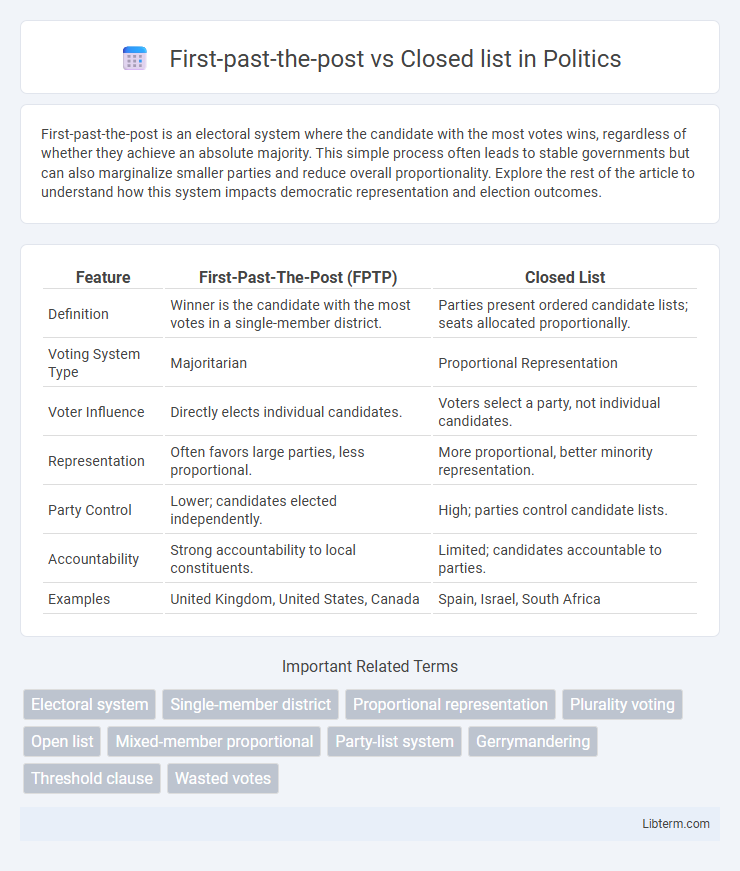First-past-the-post is an electoral system where the candidate with the most votes wins, regardless of whether they achieve an absolute majority. This simple process often leads to stable governments but can also marginalize smaller parties and reduce overall proportionality. Explore the rest of the article to understand how this system impacts democratic representation and election outcomes.
Table of Comparison
| Feature | First-Past-The-Post (FPTP) | Closed List |
|---|---|---|
| Definition | Winner is the candidate with the most votes in a single-member district. | Parties present ordered candidate lists; seats allocated proportionally. |
| Voting System Type | Majoritarian | Proportional Representation |
| Voter Influence | Directly elects individual candidates. | Voters select a party, not individual candidates. |
| Representation | Often favors large parties, less proportional. | More proportional, better minority representation. |
| Party Control | Lower; candidates elected independently. | High; parties control candidate lists. |
| Accountability | Strong accountability to local constituents. | Limited; candidates accountable to parties. |
| Examples | United Kingdom, United States, Canada | Spain, Israel, South Africa |
Introduction to Electoral Systems
First-past-the-post (FPTP) is an electoral system where voters select one candidate, and the candidate with the most votes wins the election, often leading to single-member district representation. The Closed List system, commonly used in proportional representation, allows voters to choose a party rather than individual candidates, with seats allocated based on the party's share of the vote according to a predetermined ranked list. These systems differ significantly in how representation is determined, influencing party dynamics, voter choice, and the overall proportionality of election outcomes.
Overview of First-Past-the-Post (FPTP)
First-Past-the-Post (FPTP) is an electoral system where candidates compete in single-member districts, and the candidate with the most votes wins, without needing a majority. This plurality voting method often leads to a two-party system by favoring larger parties and can result in disproportional representation. FPTP contrasts with proportional systems like Closed List, where parties gain seats based on overall vote share rather than individual district victories.
Overview of Closed List Proportional Representation
Closed List Proportional Representation (PR) allows voters to select a party rather than individual candidates, with seats allocated based on the party's share of the vote. This system enhances multiparty representation and reduces the dominance of major parties seen in First-past-the-post (FPTP) systems. Closed List PR promotes proportionality and inclusivity, ensuring minority groups and smaller parties achieve legislative representation corresponding to their electoral support.
How FPTP Works: Mechanics and Examples
First-past-the-post (FPTP) operates by awarding victory to the candidate with the most votes in a single-member district, regardless of whether they achieve an absolute majority. Each voter selects one candidate, and the candidate who receives the highest number of votes secures the seat; this system is commonly used in countries like the United Kingdom, Canada, and India. Examples include the UK general elections, where candidates compete in individual constituencies, with the winner earning direct representation in the legislative assembly.
How Closed List Systems Operate
Closed list electoral systems operate by allowing political parties to present ranked lists of candidates to voters, who cast their ballots for the party rather than individual candidates. Seats are allocated to parties proportionally based on the total vote share, with candidates chosen from the party list in the predetermined order. This system emphasizes party control over candidate selection and promotes proportional representation, contrasting with the single-member district focus of First-past-the-post systems.
Representation: Local vs. Party-Focused Outcomes
First-past-the-post (FPTP) systems emphasize local representation by electing individual candidates from defined constituencies, ensuring direct accountability to specific geographic communities. Closed list proportional representation prioritizes party-focused outcomes, as voters select parties rather than individual candidates, leading to legislatures that reflect overall party support but reduce local accountability. The contrast manifests in FPTP's strong geographic ties and closed list's enhanced proportionality across the electorate.
Voter Choice and Accountability
First-past-the-post (FPTP) systems enhance voter choice by allowing individuals to select specific candidates, fostering a direct link between constituents and representatives, which strengthens accountability through personal performance evaluation. Closed list proportional representation restricts voter choice to party-prepared lists, emphasizing party control and collective responsibility but diluting direct voter influence over individual candidates. The differing mechanisms impact democratic responsiveness, with FPTP promoting personalized accountability and closed lists encouraging party-centric governance.
Impact on Political Parties and Election Results
First-past-the-post (FPTP) systems typically favor larger political parties, often leading to a two-party dominance and a disproportional allocation of seats compared to votes, which can marginalize smaller parties. Closed list proportional representation encourages multi-party systems by allowing voters to choose parties rather than individual candidates, resulting in a more accurate reflection of the electorate's preferences and promoting coalition governments. The electoral formula of FPTP tends to create stable single-party governments, while closed list systems increase party discipline due to the central control over candidate rankings.
Advantages and Disadvantages of Each System
First-past-the-post (FPTP) electoral systems offer simplicity and clear geographic representation but often result in disproportional outcomes and underrepresentation of smaller parties. Closed list proportional representation ensures party proportionality and minority representation but limits voter choice and can strengthen party control over candidate selection. Both systems present trade-offs between voter empowerment, party influence, and the accuracy of reflecting voter preferences in legislative bodies.
Conclusion: Which System Better Serves Democracy?
First-past-the-post (FPTP) offers simplicity and clear local representation, strengthening the link between constituents and their elected officials, while often favoring larger parties and producing majority governments. Closed list proportional representation provides more accurate reflection of voter preferences, enhancing diversity and inclusivity in legislatures but can weaken direct accountability of individual representatives. In balancing effective governance and proportional fairness, the choice depends on prioritizing stable majority rule or broader representation in a democracy.
First-past-the-post Infographic

 libterm.com
libterm.com